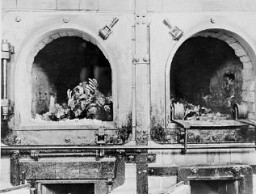<< Previous | Displaying results 2431-2440 of 6707 for "" | Next >>
-
Defeat of Nazi Germany, 1942-1945
MapBeginning in 1938, the Nazis increased their territorial control outside of Germany. By 1942, three years into World War II, Nazi Germany reached the peak of its expansion. At the height of its power, Germany had incorporated, seized, or occupied most of the continent. However, also in 1942, the Allied Powers started to systematically bomb Germany. They would continue to do so until Germany's surrender in 1945, weakening the war effort and demolishing cities. Slowly, the Allied Powers began pushing…

-
Close-up of corpses in the crematorium mortuary in Dachau
PhotoClose-up of corpses piled in the crematorium mortuary in the newly liberated Dachau concentration camp. Dachau, Germany, May 1945. This image is among the commonly reproduced and distributed, and often extremely graphic, images of liberation. These photographs provided powerful documentation of the crimes of the Nazi era.
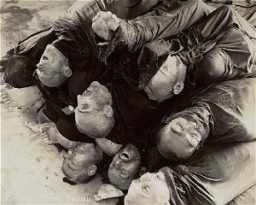
-
Bodies of victims in the Nordhausen camp
PhotoView of the main street of the Nordhausen concentration camp, outside of the central barracks (Boelke Kaserne), where the bodies of prisoners have been laid out in long rows. Nordhausen, Germany, April 13–14, 1945. This image is among the commonly reproduced and distributed, and often extremely graphic, images of liberation. These photographs provided powerful documentation of the crimes of the Nazi era.
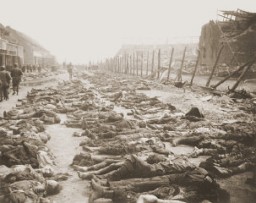
-
German civilians are forced to view a wagon piled with corpses
PhotoGerman civilians under US military escort are forced to view a wagon piled with corpses in the newly liberated Buchenwald concentration camp. Buchenwald, Germany, April 16, 1945.
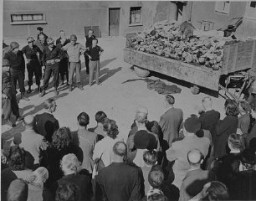
-
Victims of the Buchenwald concentration camp
PhotoA wagon is piled with the bodies of victims of the Buchenwald concentration camp. Photograph taken following the liberation of the camp. The 6th Armored Division overran the camp on April 11, 1945. Buchenwald, Germany, April 11–May 1945.
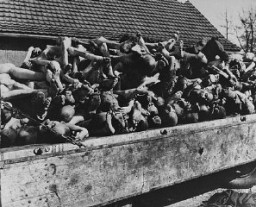
-
Former prisoners of the "little camp" in Buchenwald
PhotoFormer prisoners of the "little camp" in Buchenwald stare out from the wooden bunks in which they slept three to a "bed." Elie Wiesel is pictured in the second row of bunks, seventh from the left, next to the vertical beam. Abraham Hipler is pictured in the second row, fourth from the left. The man on the third bunk from the bottom, third from the left, is Ignacz (Isaac) Berkovicz. [He has also been identified as Abraham Baruch.] Michael Nikolas Gruner, originally from Hungary, is pictured on the bottom…
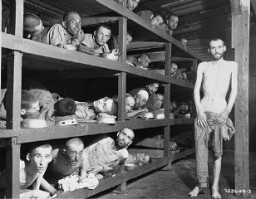
-
Bodies of victims outside the crematorium in Buchenwald
PhotoThe bodies of former prisoners are stacked outside the crematorium in the newly liberated Buchenwald concentration camp. Buchenwald, Germany, April 23, 1945. This image is among the commonly reproduced and distributed, and often extremely graphic, images of liberation. These photographs provided powerful documentation of the crimes of the Nazi era.

-
Victims of the Buchenwald camp
PhotoA wagon is piled high with the bodies of victims of the Buchenwald concentration camp. Photograph taken following the liberation of the camp. Buchenwald, Germany, April 16, 1945.
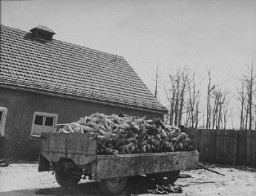
-
The charred corpse of a prisoner killed near Gardelegen
PhotoThe charred corpse of a prisoner killed by the SS in a barn just outside of Gardelegen. The SS guards locked the prisoners, who were on a death march from the Dora-Mittelbau camp, in a barn, which was then set ablaze. Gardelegen, Germany, April 16, 1945. This image is among the commonly reproduced and distributed, and often extremely graphic, images of liberation. These photographs provided powerful documentation of the crimes of the Nazi era.
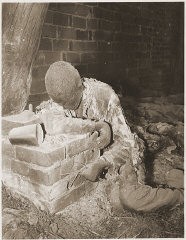
-
The charred remains of former prisoners in two crematoria ovens in the newly liberated Buchenwald concentration camp.
PhotoThe charred remains of former prisoners in two crematoria ovens in the newly liberated Buchenwald concentration camp. Buchenwald, Germany, April 14, 1945. This image is among the commonly reproduced and distributed, and often extremely graphic, images of liberation. These photographs provided powerful documentation of the crimes of the Nazi era.
